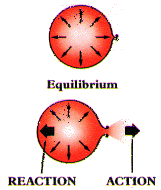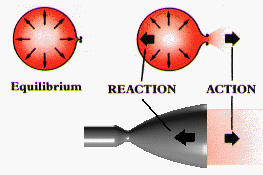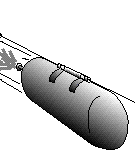Beginner's
Guide to Rockets
Rocket Propulsion
Activity
If
so instructed by your teacher, print out a worksheet page for these
problems.
From the American
Heritage Dictionary:
propulsion: is
defined as the process of driving or propelling.
propel: is defined as to cause to move or sustain in motion.
The engine on a rocket
is called the propulsion system of the rocket.
Propulsion systems
are governed by Newton's Third Law:
"For
every action, there is an equal and
opposite reaction."


Rocket Propulsion:
Thrust = Mass Flow x Velocity
Activity: Controlled
Propulsion Experiment - Balloon
A balloon provides
a simple example of how a rocket engine works. The air trapped inside
the balloon pushes out the open end, causing the balloon to move forward.
The force of the air escaping is the "action"; the movement of the balloon
forward is the "reaction" predicted by Newton's Third Law of Motion.
The distance that
a balloon will travel when restricted to a straight line is related to
the amount of air trapped inside the balloon when it is released. Similarly,
the distance a rocket will travel is related to the amount of fuel trapped
inside the rocket engine and the properties of that fuel.
This experiment will
allow us to investigate how filling balloons with different amounts of
air affect how far they will travel along a straight path. In order to
do this, we need a few equations....
Volume of a sphere:
(the amount of air in the sphere)
Volume =
1/6 x PI x (Diameter)3
Circumference of a
sphere: (how far around the sphere is )
Circumference
= PI x Diameter
Diameter, as computed
from the Circumference:
Diameter
= Circumference/PI
PI = 3.14 (a constant
value)
Materials:
- balloon
- drinking straw
- string
- tape
- printout of worksheet
Procedure:
- With pieces of
string cut to fit around the balloon, measure the circumference of the
balloon with different amounts of air in it (full,1/4 full,1/2 full,
& 3/4 full ), and record the circumference in the table shown below.
- Set aside the pieces
of string for future use.
- Slide the drinking
straw onto a piece of string.
- Choose two people
from your team to hold each end of the string taut and level.
- Place two loops
of masking tape onto the straw.
- Blow up the balloon
to its maximum capacity (greatest volume). Hold tightly onto the neck
of the balloon so that no air escapes, and attach the balloon to the
two pieces of tape. The neck of the balloon should be parallel to the
string.
- Release the neck
to let the air rush out of the balloon.
- In the table shown
below, record (a) the distance that the
balloon traveled (as marked on the string) and (b) the
amount of air in the balloon.
- Repeat steps 4-7
above, filling the balloon with different amounts
of air. Use the pieces of string you measured in Step one.
- Calculate the volume
of the balloon with the different circumferences using the equations
presented earlier.

Analyze Data:
- Complete the following table:
|
Amount
of Air
|
Circumference
(cm)
|
Diameter
(cm)
|
Distance
Traveled
(cm)
|
Volume
of Balloon
(cm)3
|
|
full
|
|
|
|
|
|
1/4 full
|
|
|
|
|
|
1/2 full
|
|
|
|
|
|
3/4 full
|
|
|
|
|
- Make a plot showing
the distance that the balloon traveled with different air volumes. (This
can be done on graph paper or with a computer software package.)
- What conclusion
can be made from this graph and how does is relate to Newton's Third
Law?
Related Sites:
Teaching Standards
Worksheet
Rocket Index
Rocket Home
Exploration Systems Mission Directorate Home
|
